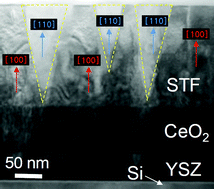Ferromagnetism in single crystal and nanocomposite Sr(Ti,Fe)O3 epitaxial films
Abstract
The ferromagnetic properties and electrical leakage current of single-phase SrTi1−xFexO3 (STF) perovskite films are compared for two different samples: a single-crystal film with a (100) orientation, and a ‘doubly oriented’ nanocomposite film consisting of (110)-oriented nanopillars embedded homoepitaxially in a (100)-oriented matrix. The STF films contain mixed valence Fe ions, with a lower average valence state present in the single crystal film. The films are under an in-plane compressive strain, and exhibit an out-of-plane magnetic easy axis due to magnetoelastic effects. The nanopillars in the double-epitaxial STF films act as single ferromagnetic domains, whereas the single-crystal films show a maze-like domain structure. Composition fluctuations seen in single-crystal films are suppressed in the double-epitaxial structure, which has a lower electrical leakage current. First-principles modeling supports a tendency for Fe ions to occupy adjacent sites. The correlations between the valence state and distribution of the Fe ions, the microstructure, and the magnetic and electrical properties provide a general method of tailoring the properties of perovskite films, which have immense technological value in a range of multiferroic, ferromagnetic, optical, spintronic and hybrid devices.


 Please wait while we load your content...
Please wait while we load your content...